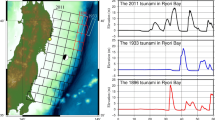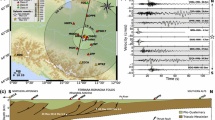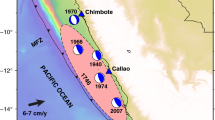Abstract
We have implemented a numerical procedure to forecast the parameters of a tsunami, such as the arrival time of the front of the first wave and the maximum wave height in real and virtual tidal stations along the Peruvian coast, with this purpose a database of pre-computed synthetic tsunami waveforms (or Green functions) was obtained from numerical simulation of seismic unit sources (dimension: 50 × 50 km2) for subduction zones from southern Chile to northern Mexico. A bathymetry resolution of 30 arc-sec (approximately 927 m) was used. The resulting tsunami waveform is obtained from the superposition of synthetic waveforms corresponding to several seismic unit sources contained within the tsunami source geometry. The numerical procedure was applied to the Chilean tsunami of April 1, 2014. The results show a very good correlation for stations with wave amplitude greater than 1 m, in the case of the Arica tide station an error (from the maximum height of the observed and simulated waveform) of 3.5% was obtained, for Callao station the error was 12% and the largest error was in Chimbote with 53.5%, however, due to the low amplitude of the Chimbote wave (<1 m), the overestimated error, in this case, is not important for evacuation purposes. The aim of the present research is tsunami early warning, where speed is required rather than accuracy, so the results should be taken as preliminary.







Similar content being viewed by others
References
Adriano, B., Mas, E., Koshimura, S., Fujii, Y., Yanagisawa, H., & Estrada, M. (2016). Revisiting the 2001 Peruvian earthquake and tsunami impact along Camana beach and the coastline using numerical modeling and satellite imaging. In: Chapter I of Tsunamis and earthquakes in coastal environments Springer Int. doi:10.1007/978-3-319-28528-3_1.
Aki, K. (1966). Estimation of earthquake moment, released energy, and stress-strain drop from the G wave spectrum. Bulletin Earthquake Research Institute, 44, 73–88.
An, C., Sepúlveda, I., & Liu, P. L.-F. (2014). Tsunami source and its validation of the 2014 Iquique, Chile Earthquake. Geophysical Research Letters, 41, 3988. doi:10.1002/2014GL060567.
Beck, S., & Nishenko, S. (1990). Variations in the mode of great earthquake rupture along the Central Peru subduction zone. Geophysical Research Letters, 17(11), 1969–1972.
Beck, S., & Ruff, L. (1989). Great earthquakes and subduction along the Peru trench. Physics of the Earth and Planetary Interiors, 57, 199–224.
Dorbath, L., Cisternas, A., & Dorbath, C. (1990). Assessment of the size of large and great historical earthquakes in Peru. Bulletin of Seismological Society of America, 80(3), 551–576.
GEBCO 30. (2017). General Bathymetric Chart of the Oceans. Web: http://www.gebco.net. Accessed Nov 2016.
Gica, E., Spillane, E., Titov, V., Chamberlin, C., & Newman, J. (2008). Development of the forecast propagation database for NOAA’s short-term inundation forecast for Tsunamis (SIFT). NOAA Technical Memorandum OAR PMEL-139, pp 89.
Greenslade, D., Allen, S., & Simanjuntak, M. (2011). An evaluation of tsunami forecasts from the T2 scenario database. Pure and Applied Geophysics, 168, 1137–1151.
IOC-Intergovernmental Oceanographic Commission. (1997). IUGG/IOC TIME project numerical method of tsunami simulation with the leap-frog scheme. UNESCO, Paris. http://www.jodc.go.jp/info/ioc_doc/Manual/122367eb.pdf. Accessed Jan 2016.
Jiménez, C. (2010). Software para determinación de ocurrencia de maremotos. Boletín de la Sociedad Geológica del Perú., 104, 25–31.
Jiménez, C., Moggiano, N., Mas, E., Adriano, B., Fujii, Y., & Koshimura, S. (2014). Tsunami waveform inversion of the 2007 Peru (Mw 8.1) earthquake. Journal of Disaster Research, 8(2), 266–273.
Jiménez, C., Moggiano, N., Mas, E., Adriano, B., Koshimura, S., Fujii, Y., et al. (2013). Seismic source of 1746 Callao Earthquake from tsunami numerical modeling. Journal of Disaster Research, 9(6), 954–960.
Lay, T., Yue, H., Brodsky, E., & An, C. (2014). The 1 April 2014 Iquique, Chile, Mw 8.1 earthquake rupture sequence. Geophysical Research Letters, 41, 3818–3825.
Mas, E., Adriano, B., Kuroiwa, J., & Koshimura, S. (2014a). Reconstruction process and social issues after the 1746 earthquake and tsunami in Peru: Past and present challenges after tsunami events. InPost Tsunami Hazards, 44, 97–109.
Mas, E., Adriano, B., Pulido, N., Jimenez, C., & Koshimura, S. (2014b). Simulation of tsunami inundation in Central Peru from future megathrust earthquake scenarios. Journal of Disaster Research, 9(6), 961–967.
Okada, Y. (1992). Internal deformation due to shear and tensile faults in a half space. Bulletin of Seismological Society of America, 82(2), 1018–1040.
Okal, E. (2009). Excitation of tsunamis by earthquakes, chapter V. In: E. Bernard, A. Robinson (Eds.), The sea: Tsunamis, volume 15 (pp. 137–177). London: Harvard University Press.
Papazachos, B., Scordilis, E., Panagiotopoulos, D., & Karakaisis, G. (2004). Global relations between seismic fault parameters and moment magnitude of Earthquakes. Bulletin of the Geological Society of Greece, 36, 1482–1489.
Silgado, E. (1978). Historia de los Sismos más notables ocurridos en el Perú (1513–1974). Boletín Nº 3. Instituto de Geología y Minería. Lima, Perú.
Acknowledgements
This research was sponsored in part by the Vice-rectorate for Research and Postgraduate from “Universidad Nacional Mayor de San Marcos” (Group Research Project 2017) and by the “Direccion de Hidrografia y Navegacion” from Peruvian Navy. In addition, we acknowledge the anonymous reviewers.
Author information
Authors and Affiliations
Corresponding author
Rights and permissions
About this article
Cite this article
Jiménez, C., Carbonel, C. & Rojas, J. Numerical Procedure to Forecast the Tsunami Parameters from a Database of Pre-Simulated Seismic Unit Sources. Pure Appl. Geophys. 175, 1473–1483 (2018). https://doi.org/10.1007/s00024-017-1660-5
Received:
Revised:
Accepted:
Published:
Issue Date:
DOI: https://doi.org/10.1007/s00024-017-1660-5




